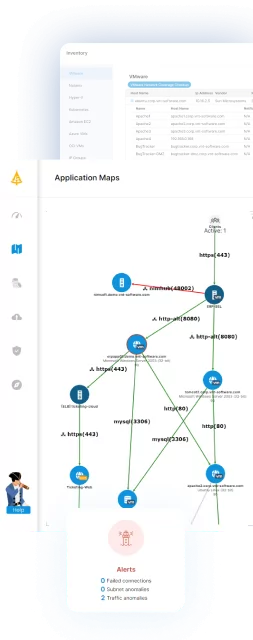What Is Cloud Network Security?
Cloud network security protects cloud-hosted networks from unauthorized access, data breaches, and cyber threats. It includes strategies and technologies to secure cloud infrastructure and ensure reliable communication. Network security measures are crucial to maintain the integrity, confidentiality, and availability of data and apps in the cloud.
Cloud network security uses various tools and practices, including firewalls, intrusion detection systems, encryption, and identity management. This approach prevents unauthorized access and data exfiltration while supporting secure user access across cloud environments. It requires balancing accessibility for legitimate users and defenses against threats.
Table of Contents
ToggleChallenges in Cloud Network Security
Cloud network security presents various challenges that organizations must navigate to ensure protection.
Complexity of Cloud Environments
Cloud environments often comprise multiple interconnected services and applications, each with unique security requirements. As organizations adopt multi-cloud and hybrid strategies, the diversity in infrastructure increases, complicating security management and monitoring efforts. Ensuring all components adhere to security controls becomes vital.
Integrating security tools across various platforms can be overwhelming, as each service may offer different security features and interfaces. Uniform security policy enforcement is challenging, requiring tools that provide integration while managing a holistic view of the security landscape.
Shared Responsibility Model
The shared responsibility model in cloud computing delineates security responsibilities between cloud service providers and customers. Providers ensure the security of the cloud infrastructure, while customers secure their data, applications, and operating systems. This model often leads to confusion, as unclear boundaries result in security gaps and increased exposure to threats.
Organizations must develop a clear understanding of their roles within this model and implement necessary security controls. Disregarding these responsibilities can lead to vulnerabilities, as evident in misconfigured storage containers or weak access management.
Lack of Visibility and Control
With critical infrastructure hosted by third-party providers, organizations may struggle to maintain oversight of their data and application security. This situation is exacerbated by the fast-paced nature of cloud services, where changes can occur rapidly and without direct intervention from the organization.
Rapid Scaling and Dynamic Resources
As organizations scale operations, maintaining a consistent security posture can become challenging, leading to gaps in protection. This dynamic environment requires automated security solutions capable of adapting to changes without compromising system integrity or performance.
Cloud Security vs Cloud Network Security
While cloud security and cloud network security are closely related, they address different aspects of protecting cloud environments.
Cloud security is a broad term encompassing all measures taken to protect cloud-based infrastructure, applications, and data from threats. This includes identity and access management, data encryption, compliance, and secure application development practices.
Cloud network security focuses specifically on securing the network layer within cloud environments. It involves protecting the transmission of data between systems, controlling access to cloud resources, and ensuring secure communication through technologies like virtual private networks (VPNs), firewalls, and intrusion detection systems.
The main distinction is the scope of responsibility. Cloud security covers the entire cloud ecosystem, whereas cloud network security zeroes in on protecting the flow of data within and between cloud systems.

Lanir specializes in founding new tech companies for Enterprise Software: Assemble and nurture a great team, Early stage funding to growth late stage, One design partner to hundreds of enterprise customers, MVP to Enterprise grade product, Low level kernel engineering to AI/ML and BigData, One advisory board to a long list of shareholders and board members of the worlds largest VCs
Tips from the Expert
In my experience, here are tips that can help you better enhance your cloud network security strategy:
- Implement adaptive threat modeling:
Regularly update the threat model to reflect changes in the cloud infrastructure. Dynamic environments require periodic reassessment to account for new attack vectors introduced by evolving cloud services or integrations. - Leverage service-level agreements (SLAs) for security guarantees:
Negotiate and enforce SLAs with cloud service providers that include specific security measures, response times, and liability clauses. Ensure the SLAs are aligned with the organization’s risk tolerance and compliance needs. - Use container-specific security solutions:
If the architecture includes containers, integrate container security tools to scan images for vulnerabilities, enforce runtime protection, and manage compliance for containerized workloads. Solutions like Kubernetes-native security tools can enhance control. - Employ network behavior analytics (NBA):
Utilize NBA tools that analyze traffic patterns for anomalies indicative of breaches or data exfiltration. Pair this with user behavior analytics (UBA) to correlate actions across the network and identify insider threats. - Test multi-cloud security interoperability:
In multi-cloud setups, security policies often don’t translate seamlessly between providers. Simulate security incidents across cloud platforms to test for and address gaps in inter-provider controls or logging visibility.
Key Components of Cloud Network Security
A network security strategy in the cloud usually incorporates the following elements.
Virtual Private Cloud (VPC)
A VPC allows organizations to create isolated, secure environments within a public cloud. It enables custom IP address ranges, subnets, and routing configurations to control traffic flow. VPCs support features like network segmentation, private connectivity, and integration with firewalls and security groups to restrict access.
Cloud-Native Firewalls
Cloud-native firewalls protect workloads hosted in the cloud. These firewalls provide advanced filtering capabilities to block malicious traffic based on IP addresses, protocols, and application behavior. They integrate with cloud management platforms to offer automated rule deployment and scaling. Organizations should configure firewalls to enforce least-privilege access.
Cloud Access Security Broker (CASB)
A CASB acts as an intermediary between users and cloud services, providing visibility, compliance enforcement, and threat protection. CASBs monitor cloud usage, enforce data loss prevention (DLP) policies, and detect anomalies indicating insider threats or breaches. They help organizations comply with regulatory requirements by enforcing security controls for cloud-hosted data and applications.
Microsegmentation
Microsegmentation divides the network into smaller segments to limit lateral movement of threats. It applies fine-grained security policies at the workload level, ensuring that even if one segment is compromised, the attacker cannot access other areas of the network. Microsegmentation is implemented using software-defined networking (SDN) tools or cloud-native solutions, increasing security in multi-cloud and hybrid environments.
Cloud Security Posture Management (CSPM)
CSPM solutions automate the process of identifying and remediating misconfigurations in cloud environments. They continuously monitor cloud infrastructure to ensure compliance with security policies and best practices. CSPM tools provide detailed visibility, risk assessment, and automated alerts, helping organizations address vulnerabilities before they can be exploited.
Identity and Access Management (IAM)
IAM ensures that only authorized users and systems can access cloud resources. It involves defining and enforcing roles, permissions, and authentication mechanisms. IAM tools provide granular control, enabling organizations to adopt a least-privilege approach and enforce multi-factor authentication. Regularly reviewing and updating IAM policies helps prevent unauthorized access and reduces the risk of privilege escalation attacks.
Cloud Encryption
Cloud encryption protects data by converting it into a secure format during storage and transit. Encryption uses algorithms to ensure that only authorized entities with the correct decryption keys can access the data. Organizations should implement end-to-end encryption, prioritize sensitive data, and manage encryption keys securely using key management services (KMS).
Related content: Read our guide to network topology mapping
Best Practices for Cloud Network Security
Organizations can ensure the security of their cloud networks by adopting the following practices.
Design Networks for Security from the Ground Up
Designing a secure network architecture involves planning the layout of network resources to minimize exposure to threats. Key practices include isolating sensitive systems using private subnets, enforcing least privilege access through role-based controls, and deploying virtual private clouds (VPCs) to segregate environments.
Use network access control lists (ACLs) and security groups to restrict inbound and outbound traffic to only what is necessary. Additionally, use distributed denial-of-service (DDoS) protection mechanisms to defend against volumetric attacks. A secure network design also leverages redundant configurations to ensure availability and resiliency during potential failures or attacks.
Use Immutable Infrastructure
Immutable infrastructure involves deploying cloud resources that cannot be modified after creation, ensuring consistency and reducing the risk of unauthorized changes. Any updates or changes to the environment are applied by replacing resources with new versions rather than altering existing ones.
This approach minimizes configuration drift and ensures environments remain in a known, secure state. Organizations can achieve this by using infrastructure-as-code (IaC) tools like Terraform or AWS CloudFormation. Combined with automated pipelines for deploying updates, immutable infrastructure helps eliminate manual interventions that may introduce vulnerabilities.
Use a Secure Key Management Service (KMS)
A secure KMS is essential for managing encryption keys used to protect sensitive data within cloud environments. Key management services provide centralized control over key creation, rotation, storage, and deletion, reducing the risk of key exposure or compromise.
Ensure that keys are stored in hardware security modules (HSMs) or equivalent secure storage systems. Enforce strict access policies to limit who can use or modify keys. Regularly rotate keys and use separate keys for different applications or datasets to reduce the blast radius of potential compromises.
Secure Remote Access
Remote access to cloud environments must be secured to prevent unauthorized entry. Organizations should adopt zero-trust principles, verifying all access requests regardless of their origin. Implement multi-factor authentication (MFA) for all users and use federated identity management for smooth and secure user authentication.
Additionally, secure remote access methods like VPNs or cloud-native bastion hosts should be used. Encrypt all remote sessions using strong protocols such as SSH or SSL/TLS. Monitor and audit remote access logs to detect and respond to anomalies promptly.
Follow Industry Standards
Adherence to industry standards and frameworks ensures cloud network security aligns with best practices and regulatory requirements. Common standards include ISO 27001, NIST cybersecurity framework (CSF), and the Center for Internet Security (CIS) Benchmarks.
These standards provide guidelines for managing risks, securing cloud operations, and achieving compliance. Regularly perform security assessments to measure adherence to these benchmarks. Aligning with industry standards also promotes trust with stakeholders by demonstrating commitment to data protection.
Implement Dependency Scanning
Dependency scanning is essential for identifying vulnerabilities in software components and third-party libraries integrated into cloud applications. These dependencies can introduce security risks if they contain unpatched vulnerabilities or outdated code.
Incorporate regular scanning into the development lifecycle to detect and address issues early. Automate the process where possible to ensure consistent and thorough analysis. Establish policies to promptly update or replace insecure dependencies, and avoid using unsupported or deprecated versions.
Cloud Network Security with Faddom
Faddom enhances cloud network security by providing real-time visibility into your IT infrastructure. Its agentless mapping uncovers hidden dependencies, detects unexpected connections, and identifies vulnerabilities to optimize security posture.
With Faddom, you can pinpoint misconfigurations, track changes, and easily ensure compliance, supporting hybrid and multi-cloud environments. Secure your cloud network confidently with Faddom.
Discover how Faddom can enhance your network security in minutes!







